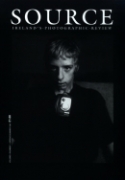What's Your Story?
'What's Your Story?' was a pair of linked exhibitions that ran concurrently in Street Level and Central Station, Glasgow, February, 1997
Review by Ray McKenzie
Issue 11 Spring Summer 1997
View Contents ▸
What's Your Story? was a pair of linked exhibitions that ran concurrently in Street Level and Central Station Glasgow, in February this year, the outcome of a series of workshops involving residents from a group of hostels for the homeless. At Street Level, there were portraits of the workshops participants made by Kathleen Little, the project leader, and Andrew Whitaker; Central Station was devoted to a display of images made by the residents themselves - mostly of themselves - using the skills they had acquired on the project. Jill and James, DePaul House
Jill and James, DePaul House
As an exercise in creative and social empowerment, What's Your Story? can be located within a clearly defined tradition in British photography, pioneered by groups like the Hackney Flashers Collective, in which artistic initiative stems directly from community need. It was also a successful realisation of Street Level's three cardinal commitments as an artists' organisation: the presentation of high quality work by practising photographers; the dissemination of skills through direct involvement; the expansion of its audience base through the use of non-gallery venues. Quite apart form the question of how well it did all of these things, What's Your Story? was a benchmark achievement for Street Level, a paradigm of everything it stands for as a force in contemporary visual culture in Scotland.
The choice of Central Station as an extension of the gallery was crucial to the meaning of the project. Here the display consisted of a large U-shaped structure with work hung on both the inside and outside faces. Partially enclosed, the interior space functioned like a miniature gallery in its own right, albeit one accessible to an audience of 'passing traffic' measured in thousands rather than the mere double figures that would normally visit Street Level on an average day. On the exterior walls the work addressed itself more directly to what I suppose we must call the 'public at large', with the legend What's Your Story? clearly visible long before the content of the individual photographs could be made out. The posture of the show was thus challenging without being confrontational, an invitation to anyone willing to make an effort to examine the evidence of a small sector of Glasgow's homeless community, and reflect on its meaning in relation to their own lives. Scott
Scott
The day I spent there as an invigilator gave me ample opportunity to assess both the work itself and the impact it was having. From the almost non-stop stream of enquiries, as well as the remarks recorded in the comments book, it was clear that the show had tapped into an immense groundswell of sympathy and understanding. The responses ranged from compassion to anger to outrage, much of it underpinned by a sense of sheer incredulity at the existence of such a problem on such a scale in the middle of what we are told is an unprecedented economic boom. Kelly
Kelly
But the biggest surprise was the number of people who claimed to have been homeless themselves at one time or another, and it quickly became clear that the problem was both deeper and more intractably than even the exhibition suggested. This fact had a profound significance for me personally because it triggered a long-buried recollection of my own experience of homelessness, many years ago. True, this was a very brief and entirely voluntary episode - a predictable phase of teenage experience of 'bumming around' before getting down to the serious business of higher education. But it was real enough to know that special form of despair that accompanies the condition of rootlessness, however temporary. I was also reminded of the peculiar significance railway stations acquire at such times. To stand in the concourse of a major station is to witness one of the great rituals of modern life. All around we see the unique drama of people in transit - a drama of tearful farewells and joyous reunions, the brisk purposeful routine of commuters arriving for work. In a railway station the meaning of people's lives is defined by the fact that they have a destination. How blessed they all suddenly seemed. Those who took the time to look at the show that Kathleen Little and her collaborators had placed in their midst were offered, among other things, a confirmation of just how lucky they were to have somewhere to go, and a forceful reminder that such good fortune should never be taken for granted.
Other articles by Ray McKenzie:
Other articles on photography from the 'Portraiture' category ▸






